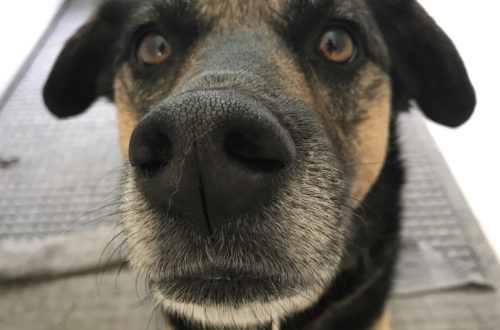Canine ESP

Does your dog head for the door half a beat before you decide it’s time to go for a walk? Does it seem like your dog is reading your mind?
Dogs and humans didn’t co-evolve for thousands of years for nothing. Dogs sometimes appear to know what we’re going to do before we do. But how?
Let me add a caveat. Not every dog does this. Mine certainly doesn’t. She’s too busy nudging my arm, heading suggestively to the door, or flopping down and heaving a dramatic sigh to bother.
The recipe for canine ESP blends human and dog ingredients. Start with human psychology and physiology. Then, add canine psychology, physiology, and self-interest. Finally, fold in a daily but unpredictable decision—say, the exact time you decide to take the dog for a walk. Now, imagine that you’re sitting at a table, computer open, your dog nearby (like me, right now).
The first ingredient is human psychology. It turns out that we frequently “decide” to act before we know it. How can that be? Psychologists perceive two systems in the human mind, called System 1 and System 2 (echoes of Thing 1 and Thing 2 from The Cat in the Hat?), that engage in an ongoing “psychodrama with two characters,” as Daniel Kahneman describes it in his 2011 book, Thinking, Fast and Slow. The first system is swift, easy, involuntary, and unconscious. The second is slow, effortful, voluntary, and conscious. You can’t switch System 1 off, and you have to switch System 2 on.
We identify with System 2, because it’s our center of awareness, reasoning, and agency. This system applies rules and theories, adds, calculates, weighs options, follows and tests the reasoning in an article like this one, and keeps us on task. It exerts self-control and solves complex problems. We couldn’t survive without it. But slow deliberate thinking consumes a lot of energy. The human brain evolved when food was scarce and so conserves energy. As a result, we don’t activate the “expensive” second system unless we must.
By contrast, System 1 is cheap. It’s our default. Easy, unconscious, and always on—it does much more than we realize. It’s our gut, basic knowledge, impressions, beliefs. It reacts automatically, swiftly. We couldn’t survive without it, either. System 1 makes many decisions that System 2 only explains—or justifies—after the fact. Fortunately, most of these decisions are good enough.
The point? System 1 frequently decides it’s time to take the dog for a walk before System 2 catches on.
The next ingredient in this recipe is human physiology. Once System 1 has decided to go for a walk, our body gets ready to go. Our temperature rises, glands in the skin secrete oils and other fluids, muscles twitch. System 2 may still be clueless, but the body prepares to act at a biochemical level. Like cartoon Pigpens in a cloud of dirt, we spew olfactory information for those able to detect and interpret it.

Enter the dog. Dogs’ evolutionary success depended on making humans and our environment their ecological niche. They became keen anthropologists, especially when their own interests were at stake. They smelled and observed our every move. The adaptive brilliance of dogs, Brian Hare and Vanessa Woods write in The Genius of Dogs, lies in “their ability to understand human communication and their motivation to cooperate with us.” That’s the canine psychology in this recipe.
Humans shaped canine evolution—that shaping, of course, defines domestication, as we turned dogs into living tools to extend our limited capacities—and one thing we selected for was smell. A dog’s sense of smell is extraordinary. As Alexandra Horowitz details in two wonderfully readable books, Inside of a Dog (2009) and Being a Dog (2016), a dog’s olfactory sensitivity outstrips ours by a factor of thousands and in some breeds possibly millions. Dogs are creatures of the nose, finely tuned sniffing machines. “To dogs,” she writes, “we are our scent.”
We use dogs’ amazing noses in more ways than ever. Trained dogs sniff out drugs, explosives, and land mines; smuggled ivory; foulbrood, a kind of bacteria that kills bees; and toxic chemicals at waste sites. They lead rescue efforts after avalanches and earthquakes. They can smell cancerous cells (though not as diagnosticians) and anticipate seizures (as service dogs). Balanced in the bow of a Boston Whaler, a Labrador named Tucker has assisted marine wildlife researchers in the Puget Sound by sniffing out Orca excrement before it sinks (not exactly the retrieving Labs were bred for) from over a mile away. The Dutch airline KLM uses Sherlock the beagle, fitted with a specially designed vest, to return lost items to passengers in the Amsterdam airport. Here in Burlington, Vermont, I know people who have hired Buster to locate bed bugs. A friend’s Labradoodle detects when her oxygen level starts to fall and alerts her, even waking her up in the middle of the night sometimes. It’s hard for humans to imagine a world made up of smells and layers upon layers of smells, but that’s our dog’s world.

Dogs also inhabit a different visual world. As the descendants of wolves, they see movement extremely well; see better in low light; have a wide angle of vision—where ours is 180 degrees, an average dog’s is 240 degrees; perceive a limited range of blue, green, and greenish yellow; have about 20:80 vision; don’t focus clearly; and see faster than we do, or more in the same amount of time.
What does it mean that dogs see faster than we do? Photoreceptor cells in the eye turn light into electrical activity through changing the pigment in the cells. While the pigment is changing, the cell cannot absorb more light. This means that, while we perceive a continuous visual loop, what we actually see is full of tiny gaps, like an old-fashioned movie. The rate of pigment change is called the flicker-fusion rate. The human flicker-fusion rate is sixty per second. Fast, right? But at seventy to eighty per second the canine rate is even faster. Do you ever suspect your dog of seeing things that aren’t there? Well, they probably are there. To our dogs, Horowitz wryly observes, “We must always seem a little slow.”
I believe what I see, but I’m wrong. I don’t see what’s objectively there but an “alternate reality,” as psychologist Daniel Simons calls it, conjured in my brain using the information my eyes provide (and that’s limited). But what about the room full of people, tables, chairs, colors, and prints on the walls—the coffee shop where I’m sitting. It’s all there just as I see it, isn’t it?
Yes, and no. I construct a visual gestalt, a sense of a coherent whole. I see details but ignore most of them in favor of my gestalt, plus the few details I care most about, and then my brain “fills in” according to my expectations of what should be there. In short, we believe that we see much more and more accurately than we actually do. This way of seeing makes humans vulnerable to an illusion called change blindness, so we frequently miss changes, even significant ones, that happen right in front of our eyes.
Not your dog. No gestalts there. Your dog’s vision, like a wolf’s, is tuned to detail and movement. Add the faster flicker-fusion rate, and a dog catches the tiniest flick of a chipmunk’s tail in the bushes.
Here’s how it all folds together. On your side: System 1 decides to go for a walk and triggers smelly (to those with real noses) physical changes that precede action, while System 2 keeps happily surfing the internet. On your dog’s side: ready (past ready!) for that afternoon walk, your dog detects changes in your scent that usually mean action and sees your foot twitch ever so slightly. Your dog leaps up and starts wagging her tail just as your System 2 “decides” it’s time to go for a walk.
You’ve been read!
It all happens incredibly fast. You just didn’t know that you “tell” your dog some things before you tell yourself. We communicate in more ways than we realize, and it’s our dogs’ super power to understand.
Across the millennia, the better a dog could read humans the more likely it would survive and reproduce. Natural evolution and co-evolution—aka domestication—worked their relentless logic, a logic that now seems like magic. Your dog really does have ESP, though the E stands for Extraordinary.
References (in the order of their first appearance):
Daniel Kahneman. Thinking, Fast and Slow. Farrar, Straus and Giroux, 2011.
Brian Hare and Vanessa Woods, The Genius of Dogs. Plume, 2013.
Alexandra Horowitz. Inside of a Dog. Scribner, 2009.
-----. Being a Dog. Scribner, 2016.
Sherlock, KLM Lost and Found Service, YouTube (2014).
Daniel Simons, “Seeing the World as It Isn’t,” theinvisiblegorilla.com, TEDxUIUC, Feb. 2011.
